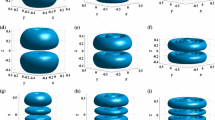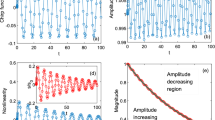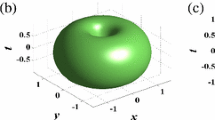Abstract
We investigate the (3 \(+\) 1)-dimensional coupled nonlocal nonlinear Schrödinger equation in the inhomogeneous nonlocal nonlinear media and derive analytical vector spatiotemporal localized solution. Based on this solution, Gaussian solitons and some symmetric multipole patterns around the point \((x, y) =(0,0)\) can be constructed. The change trends of the amplitude and width of solitons are opposite, and they finally tend to a certain value. The compression and expansion of spatiotemporal localized structures are also studied in an exponential diffraction decreasing system.
Similar content being viewed by others
Explore related subjects
Discover the latest articles, news and stories from top researchers in related subjects.Avoid common mistakes on your manuscript.
1 Introduction
The characteristics of solitons are their sustainability in time, localization in space and stability along propagating distance. Different soliton structures have been investigated in various physical fields including plasma physics, condensed matter physics and nonlinear optics [1–11].
In optics, abundant localized structures in local and nonlocal nonlinear media have been intensively studied. In local nonlinear media, spatial and spatiotemporal soliton [12–15], vortex solitons [16], light bullet [17, 18] and breather [19, 20] have been produced and play important roles in dense wavelength division multiplexing, soliton supercontinuum generation, and new soliton lasers design, etc. In nonlocal nonlinear media, two-dimensional Hermite–Gaussian solitons [21] and rotating azimuthons [22] and three-dimensional necklace solitons [23] and Hermite–Bessel solitons [24] have also been extensively studied.
In the nonlocal nonlinear media, nonlocality means that the nonlinearity of a material at a particular point depends on the wave intensity at all other material points, and thus, the nonlinear term in the nonlocal nonlinear Schrödinger equation (NNSE) is the nonlocal form associated with a symmetric and real-valued response kernel. For the strongly nonlocal case, the NNSE can be simplified into the standard Snyder–Mitchell model (a linear model) [25].
The nonlocality produces some new interesting effects. In Refs. [26, 27], authors reported that nonlocality can prevent beam collapse and stabilize multidimensional solitons. Moreover, nonlocality can also promote the stability of vector solitons [28]. However, three-dimensional vector solitons are hardly reported in the inhomogeneous nonlocal nonlinear media. In this paper, we investigate a (3 \(+\) 1)-dimensional coupled NNSE with variable coefficients and obtain analytical vector spatiotemporal localized solution. Based on this solution, the compression and expansion of spatiotemporal localized structures are studied in an exponential diffraction decreasing system.
2 Vector spatiotemporal localized solution
In general, an essential requirement of vector solitons is the absence of any interference between the single components. This requirement can either be realized by using beams of different polarization [29] or just mutually incoherent beams [30]. In (3 \(+\) 1)-dimensional inhomogeneous nonlocal nonlinear media, the propagation of vector optical solitons is governed by the following coupled NNSE
where \(u(\mathbf r ,t)\) and \(v(\mathbf r ,t)\) denote two normalized complex mode components with \(\mathbf r =(x,y,z)\), x, y represent dimensionless transverse coordinates, t is the evolution coordinate, which corresponds to the propagation distance in optics and the time in BEC, the three-dimensional “transverse” Laplacian operator \(\nabla =\frac{\partial ^2}{\partial x^2}+\frac{\partial ^2}{\partial y^2}+\frac{\partial ^2}{\partial z^2}\). Functions \(\beta (t)\) and \(\gamma (t)\) are coefficients of diffraction and gain/loss, respectively. The nonlocal nonlinear term \(\triangle n_1(\mathbf r ,t)=S(t)\int _{-\infty }^{+\infty }R(\mathbf r -\mathbf r ')(a_1|u|^2+a|v|^2)\hbox {d}{} \mathbf r \) and \(\triangle n_2(\mathbf r ,t)=S(t)\int _{-\infty }^{+\infty }R(\mathbf r -\mathbf r ')(a|u|^2+a_2|v|^2)\hbox {d}{} \mathbf r \) with the response function \(R(\mathbf r -\mathbf r ')=\exp \left[ -\frac{|\mathbf r -\mathbf r '|^2}{\sigma ^2}\right] /(\pi \sigma ^2)\). The constants \(a , a_1\) and \(a_2\) determine the ratio of the coupling strengths of the cross-phase modulation to the self-phase modulation. The limit \(\sigma \rightarrow 0\) corresponds to the case of local cubic nonlinearity, whereas \(\sigma \rightarrow \infty \) corresponds to the strongly nonlocal case.
(Color online) Spatiotemporal localized structures of \(I=|u|^2\) for \(q=0.9\) at \(t=50\): a–c \(l=0,1,2\) with \(m=0,n=1\), d–f \(l=1,2,3\) with \(m=n=1\), and g–i \(l=2,3,4\) with \(m=2,n=1\). Parameters are chosen as \(a_1=0.98,a_2=a=1,\epsilon =1,s_0=0.03,\beta _0=0.5,\sigma =0.05,A_0=0.8,\omega _0=0.4,W_0=0.5,d_1=0,d_2=1\)
(Color online) Spatiotemporal multipole structures for \(q=0\) at \(t=50\): a–c \(l=2,3,4\) with \(m=1\) and d–f \(l=4,5,6\) with \(m=2\). Parameters are chosen as the same as those in Fig. 1
(Color online) a The change of amplitude and width, b–d the compression of spatiotemporal multipole structure with \(m=2,l=5,n=1\) at \(t=8,40,120\). Parameters are chosen as the same as those in Fig. 3 except for \(\lambda =1\)
By means of the following transformation
Equation (1) changes into
In the strongly nonlocal medium, the degree of nonlocality \(\sigma \) is far more than wave characteristic width w. In this case, one expands the response function in Taylor’s series, and then the nonlinear refraction index in Eq. (3) is \(\triangle n(\mathbf r ,t)\approx s(t)r^2\) with \(r^2=x^2+y^2+z^2\).
Considering the relation between diffraction and nonlocal nonlinearity as
and using the transformation
with the width \(W(t)=\frac{W_0}{\varOmega (t)}\), the chirp function \(\varOmega (t)=[1-s_0\varTheta (t)]^{-1}\), the accumulated diffraction \(\varTheta (t)=\int ^t_0\beta (\tau )\text {d}\tau \) and constants \(A_0,W_0,s_0\), Eq. (3) changes into
whose solutions have been reported in Ref. [23]. However, we follow the procedure in Ref. [23] to obtain more general solutions and use these general solutions to produce solutions of Eq. (1).
From transformations (2) and (5) with soliton solution of Eq. (6), we obtain exact solution of Eq. (1)
where \(M(\cdot )\) and \(U(\cdot )\) are Kummer M and U functions [31], \(P_l^m(\cos \theta )\) are the associated Legendre function with the degree l and order m satisfying \(l\ge m\ge 0\) [23], and \(\cos (\theta )=Z/R\), \(\omega (t)=\omega _0[1+(\lambda -1)\sin (2\varXi )], b(t){=}-\,\frac{(2n+l+3/2)\arctan [\sqrt{\lambda }\tan (2\varXi )]}{2\sqrt{\epsilon \lambda }\omega _0^4} ,c(t)=\frac{\sqrt{\epsilon }\omega _0^2(\lambda -1)\sin (4\varXi )}{1+\lambda -(\lambda -1)\cos (4\varXi )}\) with \(R^2{=}X^2{+}Y^2{+}Z^2,\lambda {=}1/(2\epsilon \omega _0^4),\varXi (t){=}\sqrt{\epsilon }\omega _0^2T, k=\sqrt{\frac{2^{l-n+2}(2l+1)(l-m)!(2l+2n+1)!!}{4\pi \sqrt{\pi }(1+q^2)n!(l+m)![(2l+1)!!]^2}} \), the modulation depth of the pulse intensity \(q\in [0,1]\), the azimuthal angle \(\phi \) in the transverse plane (X, Y) and three constants \(\omega _0,d_1\) and \(d_2\).
3 Dynamical characteristics and evolution of spatiotemporal localized structures
In the following, the propagation behaviors of spatiotemporal localized structures are discussed in an exponential diffraction decreasing system [32, 33]
where \(\beta _{0}\) and \(\sigma \) are two positive parameters related to diffraction. When \(\sigma >0\), this system is the diffraction decreasing system.
At first, we discuss the case of \(q=0.9\), and other parameters are chosen as \(a_1=0.98,a_2=a=1,\epsilon =1,s_0=0.03,\beta _0=0.5,\sigma =0.05,A_0=0.8, \omega _0=0.4,W_0=0.5,d_1=0,d_2=1\). When \(m=0\), Gaussian solitons are exhibited in Fig. 1a–c. In particular, if \(l=0\), a sphere light bullet forms. With the addition of l, the sphere in Fig. 1a turns into a torus-shaped structure in Fig. 1b, and then a pair of drip-shaped structures appears above and below the torus-shaped structure in the middle [see Fig. 1c]. When \(m=1\), some pair-like structures exist. With the addition of l, a pair of ellipsoids in Fig. 1d changes into a pair of torus-shaped structures in Fig. 1e, and then a pair of drip-shaped structures also appears above and below the pair of torus-shaped structures in the middle [see Fig. 1f]. When \(m=2\), with the addition of l, some layer structures along the vertical direction are produced in Fig. 1g–i.
Next, we discuss spatiotemporal multipole structures for the case of \(q=0\). Some symmetric multipole patterns around the point \((x, y) =(0,0)\) can be constructed in Fig. 2. When \(m=0\), four solitons exhibit layout around the point \((x, y) =(0,0)\). With the addition of l, another layer of solitons appears gradually from Fig. 2b–c. When \(m=1\), four solitons in Fig. 2a–c split into eight solitons in Fig. 2d–f; that is, every soliton splits into two parts. Similarly, with the addition of l, the layer of multipole soliton structures also increases from Fig. 2e, f.
At last, we discuss dynamical evolution of spatiotemporal localized structures. As an example, the compression and expansion of spatiotemporal structure corresponding to Fig. 1f are exhibited in Fig. 3. From Fig. 3a, the width and amplitude are decided by \(W(z)\omega (z)\) and \(\frac{A_0k}{\omega ^{3/2}(z)W^{3/2}(z)}\), respectively. Although W(z) changes as an exponential form in the exponential dispersion decreasing system (8), \(\omega (z)\) changes with \(\sin \)-function as \(\sin (2\varXi )\). Therefore, the amplitude and width change periodically and finally tend to some fixed values. Note that the change trends of the amplitude and width are opposite, namely, the amplitude reveals an adding oscillation and finally tends to a certain value, while the width exhibits a decreasing oscillation and finally tends to a certain value. These changes are verified by the evolutional plots shown in Fig. 3b–d. Spatiotemporal soliton is compressed from \(z=8\) in Fig. 3b to \(z=50\) in Fig. 3c and then is expanded from \(z=50\) in Fig. 3c to \(z=120\) in Fig. 3d.
Compared with these compression and expansion behaviors of spatiotemporal structure, we can also discuss the compression behavior (only compression and no expansion). As another example, we study spatiotemporal structure with \(m=2,l=5,n=1\). When \(\lambda =1\), the dispersion/diffraction of pulse is exactly balanced by the nonlinearity. In this case, \(\omega (z)=\omega _0\) (constant); thus, the width and amplitude both change as an exponential form in the exponential dispersion decreasing system (8). Their changes are shown in Fig. 4a; that is, the width decreases and amplitude increases exponentially, and ultimately incline to some certain values. From Fig. 4b–d, the spatiotemporal multipole structure is compressed with the increase of the evolution coordinate.
4 Conclusions
In short, we investigate the (3 \(+\) 1)-dimensional coupled NNSE in the inhomogeneous nonlocal nonlinear media and derive analytical vector spatiotemporal localized solution built out of spherical harmonics and Kummer’s functions. Based on this solution, Gaussian solitons and some symmetric multipole patterns around the point \((x, y) =(0,0)\) can be constructed. The change trends of the amplitude and width of solitons are opposite, and they finally tend to a certain value. The compression and expansion of spatiotemporal localized structures are also studied in a exponential dispersion decreasing system. These results may give new insight into laser devices emitting ultra-short pulses, all-optical networks and experimental realization in nonlocal nonlinear BEC.
References
Wang, Y.Y., Dai, C.Q.: Caution with respect to “new” variable separation solutions and their corresponding localized structures. Appl. Math. Model. 40, 3475–3482 (2016)
Zhou, Q., Yu, H., Xiong, X.: Optical solitons in media with time-modulated nonlinearities and spatiotemporal dispersion. Nonlinear Dyn. 80, 983–987 (2015)
Guo, R., Zhao, H.H., Wang, Y.: A higher-order coupled nonlinear Schrödinger system: solitons, breathers, and rogue wave solutions. Nonlinear Dyn. 82, 2475–2484 (2016)
Dai, C.Q., Wang, Y.Y.: Spatiotemporal localizations in (3 + 1)-dimensional PT-symmetric and strongly nonlocal nonlinear media. Nonlinear Dyn. 83, 2453–2459 (2016)
Kong, L.Q., Dai, C.Q.: Some discussions about variable separation of nonlinear models using Riccati equation expansion method. Nonlinear Dyn. 81, 1553–1561 (2015)
Lü, X., Lin, F.H., Qi, F.H.: Analytical study on a two-dimensional Korteweg-de Vries model with bilinear representation, Bäcklund transformation and soliton solutions. Appl. Math. Model. 39, 3221–3226 (2015)
Lü, X., Lin, F.H.: Soliton excitations and shape-changing collisions in alpha helical proteins with interspine coupling at higher order. Commun. Nonlinear Sci. Numer. Simul. 32, 241–261 (2016)
Lü, X.: Madelung fluid description on a generalized mixed nonlinear Schrödinger equation. Nonlinear Dyn. 81, 239–247 (2015)
Lü, X., Ma, W.X., Yu, J., Lin, F.H., Khalique, C.M.: Envelope bright- and dark-soliton solutions for the Gerdjikov–Ivanov model. Nonlinear Dyn. 82, 1211–1220 (2015)
Mani Rajan, M.S., Mahalingam, A.: Nonautonomous solitons in modified inhomogeneous Hirota equation. Nonlinear Dyn. 79, 2469–2484 (2015)
Mani Rajan, M.S., Mahalingam, A., Uthayakumar, A., Porsezian, K.: Observation of two soliton propagation in an erbium doped inhomogeneous lossy fiber with phase modulation. Commun. Nonlinear Sci. Numer. Simul. 18, 1410–1432 (2013)
Mani Rajan, M.S., Hakkim, J., Mahalingam, A., Uthayakumar, A.: Dispersion management and cascade compression of femtosecond nonautonomous soliton in birefringent fiber. Eur. Phys. J. D 67, 150–157 (2013)
Vijayalekshmi, S., Mani Rajan, M.S., Mahalingam, A., Uthayakumar, A.: Hidden possibilities in soliton switching through tunneling in erbium doped birefringence fiber with higher order effects. J. Mod. Opt. 62, 278–287 (2015)
Dai, C.Q., Wang, Y., Liu, J.: Spatiotemporal Hermite–Gaussian solitons of a (3 + 1)-dimensional partially nonlocal nonlinear Schrodinger equation. Nonlinear Dyn. 84, 1157–1161 (2016)
Dai, C.Q., Wang, D.S., Wang, L.L., Liu, W.M.: Quasi-two-dimensional Bose-Einstein condensates with spatially modulated cubic-quintic nonlinearities. Ann. Phys. 326, 2356–2368 (2011)
Lai, X.J., Jin, M.Z., Zhang, J.F.: Two-dimensional self-similar rotating azimuthons in strongly nonlocal nonlinear media. Chin. J. Phys. 51, 230–242 (2013)
Dai, C.Q., Wang, X.G., Zhou, G.Q.: Stable light-bullet solutions in the harmonic and parity-time-symmetric potentials. Phys. Rev. A 89, 013834 (2014)
Chen, Y.X.: Sech-type and Gaussian-type light bullet solutions to the generalized (3 +1)-dimensional cubic-quintic Schrodinger equation in PT-symmetric potentials. Nonlinear Dyn. 79, 427–436 (2015)
Dai, C.Q., Wang, Y.Y., Zhang, X.F.: Controllable Akhmediev breather and Kuznetsov-Ma soliton trains in PT-symmetric coupled waveguides. Opt. Express 22, 29862–29867 (2014)
Dai, C.Q., Wang, Y.Y.: Controllable combined Peregrine soliton and Kuznetsov-Ma soliton in PT-symmetric nonlinear couplers with gain and loss. Nonlinear Dyn. 80, 715–721 (2015)
Yang, B., Zhong, W.P., Belic, M.R.: Self-similar Hermite–Gaussian spatial solitons in two-dimensional nonlocal nonlinear media. Commun. Theor. Phys. 53, 937–942 (2010)
Lai, X.J., Jin, M.Z., Zhang, J.F.: Two-dimensional self-similar rotating azimuthons in strongly nonlocal nonlinear media. Chin. J. Phys. 51, 230–242 (2013)
Zhong, W.P., Belic, M.R.: Three-dimensional optical vortex and necklace solitons in highly nonlocal nonlinear media. Phys. Rev. A 79, 023804 (2009)
Xu, S.L., Belic, M.R.: Three-dimensional Hermite-Bessel solitons in strongly nonlocal media with variable potential coefficients. Opt. Commun. 313, 62–69 (2014)
Lopez-Aguayo, S., Gutierrez-Vega, J.C.: Elliptically modulated self-trapped singular beams in nonlocal nonlinear media: ellipticons. Opt. Express 15, 18326 (2007)
Yakimenko, A.I., Lashkin, V.M., Prikhodko, O.O.: Dynamics of two-dimensional coherent structures in nonlocal nonlinear media. Phys. Rev. E 73, 066605 (2006)
Zhong, W.P., Yi, L.: Two-dimensional Whittaker solitons in nonlocal nonlinear media. Phys. Rev. A 75, 061801 (2007)
Liang, G., Li, H.G.: Polarized vector spiraling elliptic solitons in nonlocal nonlinear media. Opt. Commun. 352, 39–44 (2015)
Manakov, S.V.: On the theory of two-dimensional stationary self-focusing of electromagnetic waves. Zh. Eksp. Teor. Fiz. 65, 505–516 (1973)
Chen, Z., Segev, M., Coskun, T., Christodoulides, D.N.: Self-trapping of dark incoherent light beams. Opt. Lett. 21, 1436–1438 (1996)
Abramowitz, M., Stegun, I.: Hand Book of Mathematical Functions. Dover, NewYork (1965)
Dai, C.Q., Wang, Y.Y., Wang, X.G.: Ultrashort self-similar solutions of the cubic-quintic nonlinear Schrodinger equation with distributed coefficients in the inhomogeneous fiber. J. Phys. A Math. Theor. 44, 155203 (2011)
Dai, C.Q., Zhu, H.P.: Superposed Kuznetsov-Ma solitons in a two-dimensional graded-index grating waveguide. J. Opt. Soc. Am. B 30, 3291–3297 (2013)
Acknowledgments
This work was supported by the National Natural Science Foundation of China (Grant Nos. 11375007 and 11574272) and Zhejiang Provincial Natural Science Foundation of China (Grant Nos. Y17F050046 and LY16A040014). Dr. Chao-Qing Dai is also sponsored by the Foundation of New Century “151 Talent Engineering” of Zhejiang Province of China and Youth Top-notch Talent Development and Training Program of Zhejiang A&F University.
Author information
Authors and Affiliations
Corresponding author
Rights and permissions
About this article
Cite this article
Dai, CQ., Fan, Y., Zhou, GQ. et al. Vector spatiotemporal localized structures in (3 \(+\) 1)-dimensional strongly nonlocal nonlinear media. Nonlinear Dyn 86, 999–1005 (2016). https://doi.org/10.1007/s11071-016-2941-8
Received:
Accepted:
Published:
Issue Date:
DOI: https://doi.org/10.1007/s11071-016-2941-8








